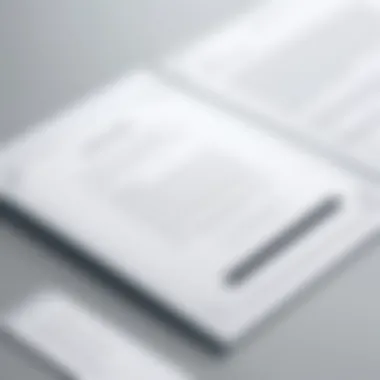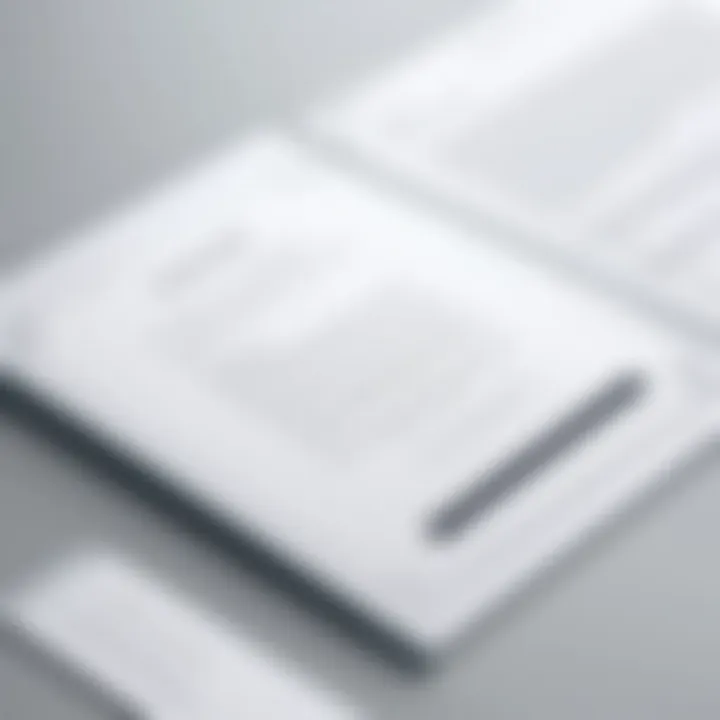Crafting the Perfect Formal Invitation Email for Events


Intro
Creating a formal invitation email requires careful consideration and attention to detail. It is essential to comprehend the significance of maintaining a formal tone while communicating effectively. Regardless of the event's nature—be it a corporate gathering or a social celebration—the right email invites set the tone for what participants can expect. This section offers essential insights on constructing an impressive invitation that leaves a lasting impact.
Components of a Formal Invitation Email
In this digital age, mastering the fundamentals of creating formal invitation emails has become crucial. Attention to detail is not merely an option; it's a necessity. Here are key components to include in your invitation:
- Subject Line: This is the first thing recipients see. It should be clear and straight to the point, summarizing the invite purpose.
- Greeting: Proper salutation matches the expected formality. Use titles and surnames when appropriate.
- Event Details: Clearly state the event name, date, and location. It should be straightforward and informative.
- Purpose of the Event: Briefly describe the reason for the event. Ensure it's meaningful to engage the recipients.
- RSVP Instructions: Give clear guidance on how and by when attendees should respond.
- Closing: End with a professional conclusion. Expressions of gratitude or anticipation for the responses can enhance the closing.
Common Mistakes to Avoid
While creating a formal invitation email, avoiding these common mistakes ensures professionalism:
- Overly Casual Language: A formal invitation demands formality in language. Avoid colloquialisms and casual phrases.
- Neglecting Proofreading: Typos or grammatical errors can detract from the professionalism of your email. Review the invitation multiple times.
- Lack of Clarity: Ensure all details such as time, date, and purpose are well-articulated.
Best practice recommends sticking to a simple structure while using precise language.
Culmination
Effectively crafting a formal invitation email is not solely about adherence to etiquette but about forging a connection with your audience. Keeping your invitation timely, clear, and professionally appealing makes it more likely your participants will embrace your message and respond positively.
Understanding the Importance of Formal Invitations
Formal invitations play a crucial role in event planning and communication. They serve as a primary medium to convey information to the attendees, establishing context and expectations surrounding an occasion. This segment of the article will explore why these invitations matter and how they can shape your events.
Defining Formal Invitations
A formal invitation is an official request sent to individuals to attend a specific event. Unlike casual invites, these communications follow certain conventions in language, tone, and format. They typically include detailed information about the event, including its purpose, date, time, venue, and any necessary instructions for attendees. Having a clear definition makes it easier to recognize the importance of being thought-provoking and concise in crafting message content.
Purpose and Significance
Creating a Professional Image
Creating a professional image through formal invitations is significant to representing oneself or an organization effectively. Professionalism pertains to consistency in communication and reflecting commitment to quality. Using proper language, format, and clarity maintains an organization's image in the eyes of both participants and stakeholders. When well-crafted, formal invitations enhance credibility.
- Benefits of such presentations include an organized approach to the invitation process.
- Professionalism helps differentiate invitations from mundane social requests, further establishing the value of the event.
- Focusing on single clear points fosters genuine engagement.
Establishing Credibility
Establishing credibility through formal communications reinforces trust and reliability. A well-prepared invitation signifies to recipients that the occasion is significant. Assuring attendees they are equally valued cultivates a friendly atmosphere. When directives and nuances are presented thoughtfully, people are more likely to recognize their importance.
- One characteristic of this approach is delivering accurate information that leads to an informed audience.
- Attracting the right participants ensures that discussions remain meaningful and inspired.
- Ultimately, gaining established trust increases attendance rates.
When attendees believe in the itinerary and respect the impending gathering through formal invites, the chances that they show up rise significantly.
Key Elements of a Formal Invitation Email
In constructing a formal invitation email, understanding carefully the key elements will enhance the effectiveness and ensure clarity to the recipients. Each component plays a critical role in conveying the necessary information and building a professional image. The right details inspire responses and create an inviting atmosphere that sets the stage for the event. Putting emphasis on these elements allows for better organization and understanding for the audience.
Subject Line Considerations
The subject line is essentially the first impression a recipient has of the email. A well-crafted subject line should be succinct and descriptive. It needs to capture the essence of the event while piquing the interest of the recipient. Avoid overly complex phrases; simplicity is more effective.
Consider including the event name and date in the subject line. For example, instead of a vague “Invitation,” use something precise like “Join Us for the National Technology Conference on October 15.” Such clarity helps in ensuring recipients understand what the email entails before even opening it.
Salutation and Greeting
When composing the salutation, it's essential to maintain an air of decorum. Use formal titles and names whenever possible, for instance, “Dear Dr. Smith” or “Greetings Mr. Jones.” Avoid overly casual greetings like “Hey” or “Hi,” as these might detract from the formality. Specificity matters here.


In cases where circumstances are less formal, such as among colleagues, greetings can be slightly warmer but still maintain professionalism. However, it is critical to err on the side of caution in a formal setting.
Event Details
The body of the invitation turns to the event details which encompass crucial information regarding the gathering itself.
Date and Time
Clearly outlining Date and Time is a fundamental aspect of any formal invitation email. The date serves as the foundation for attendees; thus, declaring it prominently can’t be overemphasized. Specify the time zone as well, especially for virtual events. Missing this discerning detail can lead to confusion among guests from different time zones.
Consistently use a standard format. For example, “October 15, 2023, at 4 PM EST” avoids misinterpretation. This clarity fosters better planning on the part of your attendees. Providing the specific time enhances reliability in correspondence and contributes to a professional demeanor.
Venue or Platform
The section explaining the Venue or Platform should reaffirm what participants should expect. If it is a physical location, providing complete information such as address and any unique instructions regarding parking is beneficial. In contrast, for virtual events, specify the platform being used—Zoom, Microsoft Teams, or Google Meet.
Traits of the site itself should be incorporated. For instance, if the location offers accessible entry or ambiance that is noteworthy, mention that. Equally, if using an online platform presents any unique features or requirements, saying so can help smooth out the registration flow for guests.
Special Instructions
Including any Special Instructions gets attendees prepared for the event. Instructions could involve attire, protocols for interaction, or materials to bring. Being direct and explicit helps avoid any misunderstandings excels.
Special features, like specific registration details or guidelines for tech etiquette during a virtual event, are also important to state openly. Whatever the special aspect is, clarity here ensures the event progresses smoother and helps everyone remain on the same page.
Closing Statements
Closing statements serve as a polite way to check back in with the audience. A short message expressing enthusiasm about the event is often effective. Also, a reminder that RSVP is appreciated can drive confirmations.
Consequently, inclusive signatures providing contact details might facilitate questions or clarifications by the recipients. Maintain structure to leave a positive impression and convey professionalism right to the end of the communication.
Choosing the Right Tone
Choosing the right tone in a formal invitation email is a crucial aspect that influences how the message is perceived by recipients. A well-chosen tone can convey respect and professionalism. It reflects your awareness of the audience and the purpose of the event. Striking the appropriate balance helps to foster a sense of trust and can ensure higher engagement with the invitation.
Balancing Formality and Approachability
Developing a tone that combines formality and approachability can be challenging. Too much formality can make the email feel rigid and unwelcoming, while overly casual language may undermine the significance of the event. It is essential to consider the nature of the event. For example, a corporate launch may require more formality than a casual gathering. Specific phrases can aid in balancing these elements.
- Use formal titles and surnames where necessary to maintain respect.
- However, doping in warm greetings can soften the tone, making the communication feel more personal.
- Maintaining a professional structure ensures clarity, but don’t shy away from using polite and friendly language.
By carefully weaving these two tones, the recipient is more likely to engage positively. An invitation should sound inviting while retaining professionalism. This dynamic contributes to defining the event's sentiment from its outset.
Recognizing Audience Expectations
Understanding audience expectations is key to setting the right tone. Different demographics or professional settings will dictate how formal or casual your email should be. This reflects not only on your ehtos but also on how attendees might perceive the actual event.
- Industry norms often indicate the level of formality. A legal seminar may demand stricter language compared to a tech meetup.
- Cultural context also matters. In some cultures, a more direct approach may be favored, while in others, subtler communication is better received.
Ultimately, being aware of your audience aids in crafting a message that resonates. This creates an environment of comfort and inclusivity, where recipients feel both welcomed and appreciated. Meeting their expectations keeps communication effective and ensures a successful turnaround.
Best Practices for Writing Formal Invitation Emails
Creating a formal invitation email involves specific best practices to convey professionalism. When followed, these practices enhance communication and prevent misunderstandings. Knowing how to effectively write these emails helps create a positive impression.
Clarity and Conciseness
Clarity is essential in any formal invitation email. The main purpose of an invitation is to inform the invitee about the event details straightforwardly.
To achieve this:
- Use simple language. Avoid jargon that may confuse the reader.
- Structure the information clearly. Organize the email with headings, bullet points, and straightforward sentences to guide the reader.
- Stick to the essentials. Provide vital information only. This includes event date, time, location, and purpose. By avoiding unnecessary details, you help prevent the reader from feeling overwhelmed.


In short, a clear and concise invitation respects the time and understanding of the recipient.
Proofreading and Editing
Proofreading plays a critical role in preparing your formal invitation email. Errors can tarnish the impression of professionalism you wish to present. Attention to detail reflects your dedication.
To ensure accuracy in your email:
- Check for grammar and spelling mistakes. This should be part of your standard review process. Easy to overlook at times, a mispelled word can change perception.
- Read aloud. Hearing the text can help catch awkward phrasing and errors you might miss on the screen.
- Take a break before the final review. This allows you to approach the text with fresh eyes.
Ultimately, thorough proofreading and editing ascertain accuracy and professionalism, significantly contributing to the email's success.
Remember: A few simple checks can make your invitation not just clear, but compelling.
Common Mistakes to Avoid
Crafting a formal invitation email requires attention to detail and a precise approach. Mistakes in this stage can undermine the professionalism of both the sender and the event itself. Understanding common errors helps to create an invitation that is not only clear but also compelling.
Overlooking Essential Details
One critical error is failing to include essential details of the event. Each piece of information plays a role in the overall clarity and effectiveness of the message. Omitting key aspects such as the event date, time, venue, and RSVP instructions can confuse recipients. This confusion might lead to low attendance, or even worse, miscommunication of the intended message.
To avoid these issues, include the following details:
- Date and Time: Clearly state when the event will occur, ideally indicating the time zone to accommodate diverse recipients.
- Venue or Platform: Specify whether it’s in-person or virtual, and if applicable, provide a complete address or link to the online platform.
- RSVP Instructions: Advise recipients on how to confirm their attendance, including any deadlines for responses.
A precise invitation includes comprehensive information that prevents misunderstandings and sets proper expectations.
Using Informal Language
Another mistake is using language that lacks the formality suited to the circumstance. Informal tone can diminish the professionalism of the invitation and may lead to perception issues about the importance of the event. Proper formality conveys respectful consideration for the attendees.
While casual conversations can be appropriate in some contexts, they have no place in formal invitations. Avoid phrases that sound too conversational or unprofessional. Instead, efforts should focus on the use of correct grammar, well-structured sentences, and respectful address.
Monitor your vocabulary choices and review the language to ensure it aligns with the audience. Uniformity in tone across the communication reinforces the overall professional appearance. Adopting professionalism in language will likely increase the recipient's willingness to engage positively with the invitation and the event it promotes.
Creating a Template for Formal Invitations
Creating a formal email template is essential for ensuring consistency and professionalism in your communications. A well-structured template not only saves time but also helps maintain brand identity across invitations. It offers a clear framework that can be easily customized for each event, reducing the risk of overlooking important details. Moreover, a template allows for the quick adaptation of the main elements of an invitation while leaving room for personalization, which is critical when addressing varying audiences.
Designing an Email Template
When designing an email template, functionality and aesthetic appeal must be balanced. The layout should be straightforward and easy to navigate. Begin with branding elements at the top, such as your company logo, followed by a clear and concise subject line. Use specific sections for the event title, date, time, location, and RSVP instructions. It is useful to utilize bullet points or numbered lists where possible to emphasize important details clearly.
Here are several crucial factors to consider when designing your template:
- Clarity: Ensure that the font is legible and contrasts well with the background color.
- Structure: Use headings, bullet points, and sections to break up the content visually.
- Consistency: Maintain uniformity in colors and fonts to align with your brand identity.
Key Considerations
When working on the templates, you might also consider deadliness that matter for your industry, timelines for sending, and the audience preferences. Each template should be versatile and inclusive yet cater to the formal nature of your event.
Incorporating Brand Elements
Incorporating your brand elements into the email template signifies professionalism and aids recognition. Brand elements include your logo, color schemes, and font styles, which should reflect your corporate identity. These consistent features provide a sense of familiarity for your recipients and can potentially impact their engagement.
When incorporating branding:
- Use of Logo: Place your logo in a prominent position, preferably at the top. This adds immediate recognition.
- Color Palette: Align the invitation’s color scheme with your brand’s colors for a cohesive look.
- Font Choices: Choose fonts that are representative of your brand and are easy to read.
Remember, first impressions matter. A well-branded template can create a lasting effect.


Post-Sending Actions
After sending a formal invitation email, participants expect a certain level of follow-up actions. This is not merely a good practice; it enhances the overall event experience and shows respect for the attendees’ time and interest. Engaging in post-sending actions allows the sender to maintain communication, clarify impolitu or ambiguities, and streamlines event management. Let’s explore the key aspects of following up and collecting feedback.
Following Up with Recipients
Confirmation of Attendance
Confirmation of attendance is critical for event planning. When senders request RSVP from their guests, it ensures that they can gauge interest levels and collect an estimated number of attendees. This action brings about a sense of assurance for both the organizer and the participants. The characteirstic of this confirmation is its proactive nature; reaching out confirms one’s engagement in the forthcoming distibution of information. Such a step is a popular choice because it aligns with better event management practices.
Attending to confirmations presents its pros and cons.
- Advantages:
- Disadvantages:
- It clarifies the guest count for resources and catering.
- It helps in sending updates and reminders to confirmed participants.
- Some invitees may ignore the request, leading to unclear attendee numbers.
- Timing is critical; if done too late, the information may not be relevant.
Providing Additional Information
Providing additional information after sending the invite serves as an opportunity to enrich attendees’ experience. This can include directions to the venue, agenda for the event, or last-minute changes. The key characteristic here is that it displays a commitment to assisting guests. By proactively giving information, organizers can improve satisfaction and preparedness levels among the attendees.
The unique feature of these follow-ups makes it a worthwhile concern in formal invitation interactions with the guests:
- Advantages:
- Disadvantages:
- Helps address queries and uncertainties, enhancing the excitement trap.
- Builds a more informed and enthusiastic cohort of attendees, increasing engagement at the event.
- If information overloads guest, it may lead to confusion.
- Unclear communication might mislead attendees if not presented correctly.
Collecting Feedback
Finally, collecting feedback post-event acts as a crucial step towards improvement and future planning. Effective feedback can inform the organizers about what succeeded and what didn’t, providing data for analyzing strengths and weaknesses. Engaging with participants for their insights ensures that their voices are heard, and adjustments can be made continuously. Such actions underline another layer of professionalism on the part of the organizer, stating clearly that they value their attendees’ opinions.
The aim of these post-sending actions is fundamentally about enhancing engagement and ensuring a more polished professional image.
Emphasizing these practices leads to refined approaches, establishing a rhythm to improve event coordination. Ultimately, fostering this feedback-rich dialogue cultivates a more invested audience, paving the way for more successful future events.
Real-Life Examples of Formal Invitation Emails
In the context of crafting a formal invitation email, it is essential to understand the impact of real-life examples. These examples provide valuable insights into composition, tone, style, and really convey the professionalism required for various audiences. Analyzing successful invitations aids anyone anticipating their events to resonate appropriately with attendees. Structure becomes evident in how formal invitation emails operate in sending clear messages concerning essential details, such as time, location, and format.
Effective examples reflect practical elements such as clarity and impact. They educate the witness of various styles and formats found in the professional world. Learning through examples ensures one avoids common mistakes while creating memorable invitations, regardless of the event type. This insight assists in identifying pivotal design choices and wording best suited for each category of recipient, thereby integrating important principles and practices that enhance overall communication effectiveness.
Corporate Event Invitations
Corporate event invitations typically aim to reflect the values of a company while addressing a professional audience. They incorporate certain key elements to instill a sense of importance. Typically, they begin with a formal subject line to invoke the value of the occasion.
- Start with a respectable salutation, like Dear Team or Dear [Recipient’s Name].
- Specify the details with clarity: Date and time, location, and purpose of the event. Including RSVP guidelines is also substantial as it prompts responses.
An example of a structured corporate invitation may read:
Subject: Invitation to Annual Company Meeting Dear Team, We invite you to the Annual Company Meeting scheduled for November 15, 2023, at 10:00 AM, at our headquarters. This meeting will summarize our annual performance and discuss objectives for the upcoming year. Please confirm your attendance by November 1st.
Through attendees evaluating real-life corporate invitation examples, they might notice the influence of tone and graphic elements used. A formal typeface or appropriate logos improve visual appeal. As a brief but potent reference point, remember each detail within the message serves to reflect the corporate identity.
Social Gatherings
While corporate events require a formal touch, social gatherings might lean toward a slightly approachable yet respectful tone. Understanding how to balance friendlier language with a degree of formality allows a well-rounded social invitation.
- Commencing with an inviting salutation can enhance the feeling of conviviality: Hi [Friend’s Name].
- Gearing toward personalized wording engages recipients. Clearly outline the who, what, when, and where as these are notably crucial for social events.
An effective example could be as follows:
Subject: You’re Invited to Our Charity Dinner Hi Jessica, I am excited to invite you to our Charity Dinner on December 10 at 5 PM at the Riverside Banquet Hall. We would love your company and support in raising funds for the local animal shelter. Please let me know if you can make it.
More informal but keeping touch of formality ensures the communication appears genuine. Taking cues from existing examples aids in grasping the types of friendly registrations possible within structured limits. Collecting these diverse samples as references allows for broader understanding on how different social parameters fit unique events more harmoniously.







